 | –≠–ª–µ–∫—Ç—Ä–æ–Ω–Ω—ã–π –∫–æ–º–ø–æ–Ω–µ–Ω—Ç: LM4702B | –°–∫–∞—á–∞—Ç—å:  PDF PDF  ZIP ZIP |
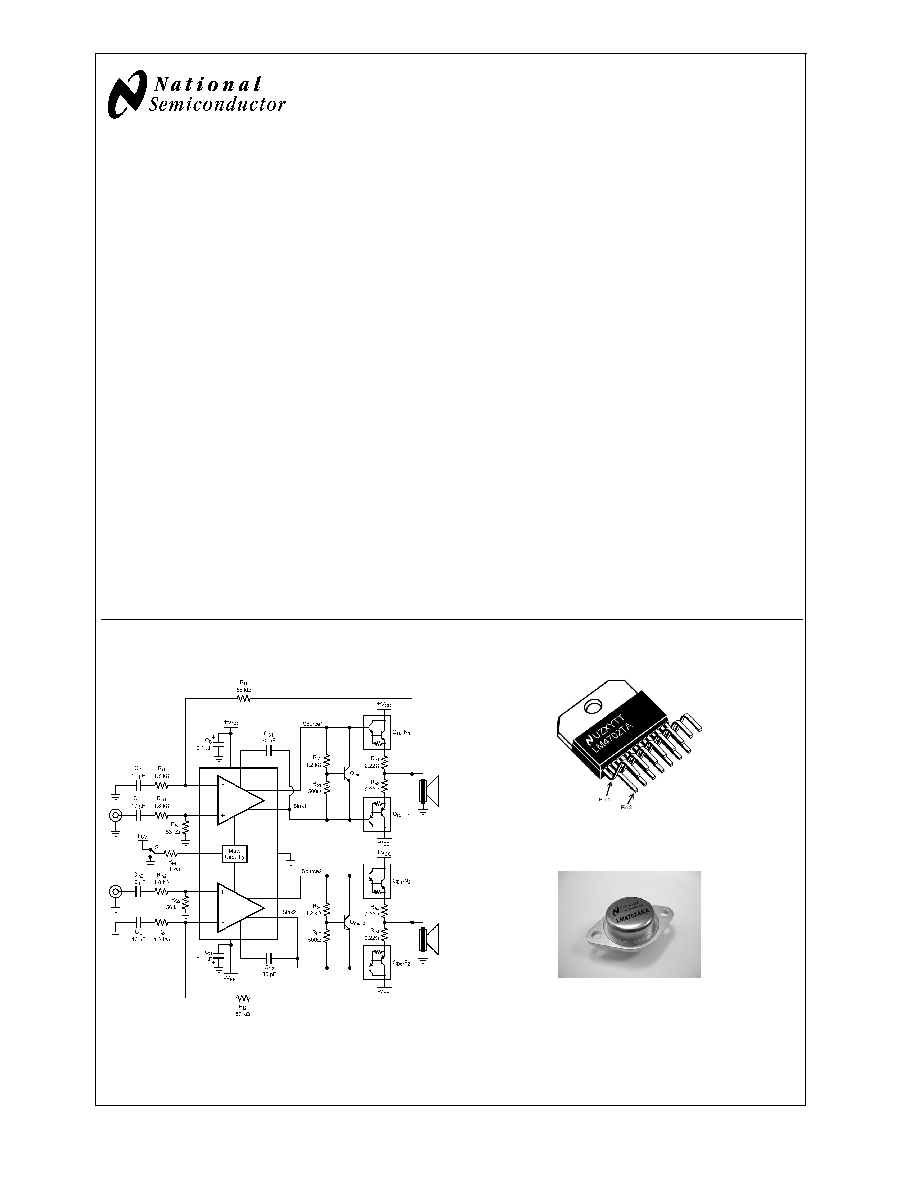
LM4702 Overture
Æ
Audio Power Amplifier Series
Stereo High Fidelity 200 Volt* Driver with Mute
General Description
The LM4702 is a high fidelity audio power amplifier driver
designed for demanding consumer and pro-audio applica-
tions. Amplifier output power may be scaled by changing the
supply voltage and number of output devices. The LM4702
is capable of delivering in excess of 300 watts per channel
single ended into an 8 ohm load in the presence of 10% high
line headroom and 20% supply regulation.
The LM4702 includes thermal shut down circuitry that acti-
vates when the die temperature exceeds 150∞C. The
LM4702's mute function, when activated, mutes the input
drive signal and forces the amplifier output to a quiescent
state.
The LM4702 is available in 3 grades that span a wide range
of applications and performance levels. The LM4702C is
targeted at high volume applications. The LM4702B (in de-
velopment) includes a higher voltage rating along with the
tighter specifications. The LM4702A (in development) is the
premium part with the highest voltage rating, fully specified
with limits over voltage and temperature, and is offered in a
military 883 compliant TO-3 package.
* Tentative Max Operating voltage for the LM4702A,
LM4702B (in development)
Key Specifications
j
Wide operating voltage range
LM4702A (in development)
±
20V to
±
85V
LM4702B (in development)
±
20V to
±
80V
LM4702C
±
20V to
±
75V
j
Equivalent Noise
3µV
j
PSRR
110dB (typ)
j
THD
0.001%
Features
n
Very high voltage operation
n
Scalable output power
n
Minimum external components
n
External compensation
n
Thermal Shutdown and Mute
Applications
n
AV receivers
n
Audiophile power amps
n
Pro Audio
n
High voltage industrial applications
Typical Application and Connection Diagrams
20158319
FIGURE 1. Typical Audio Amplifier Application Circuit
20158302
Plastic Package -- 15 Lead TO-220
(for LM4702; LM4702B, in development)
20158320
Metal Can -- 15 Lead TO-3
(for LM4702A, in development)
SPiKe
TM
Protection and Overture
TM
are trademarks of National Semiconductor Corporation.
September 2005
LM4702
Overture
Æ
Stereo
High
Fidelity
200
V
olt*
Driver
with
Mute
© 2005 National Semiconductor Corporation
DS201583
www.national.com
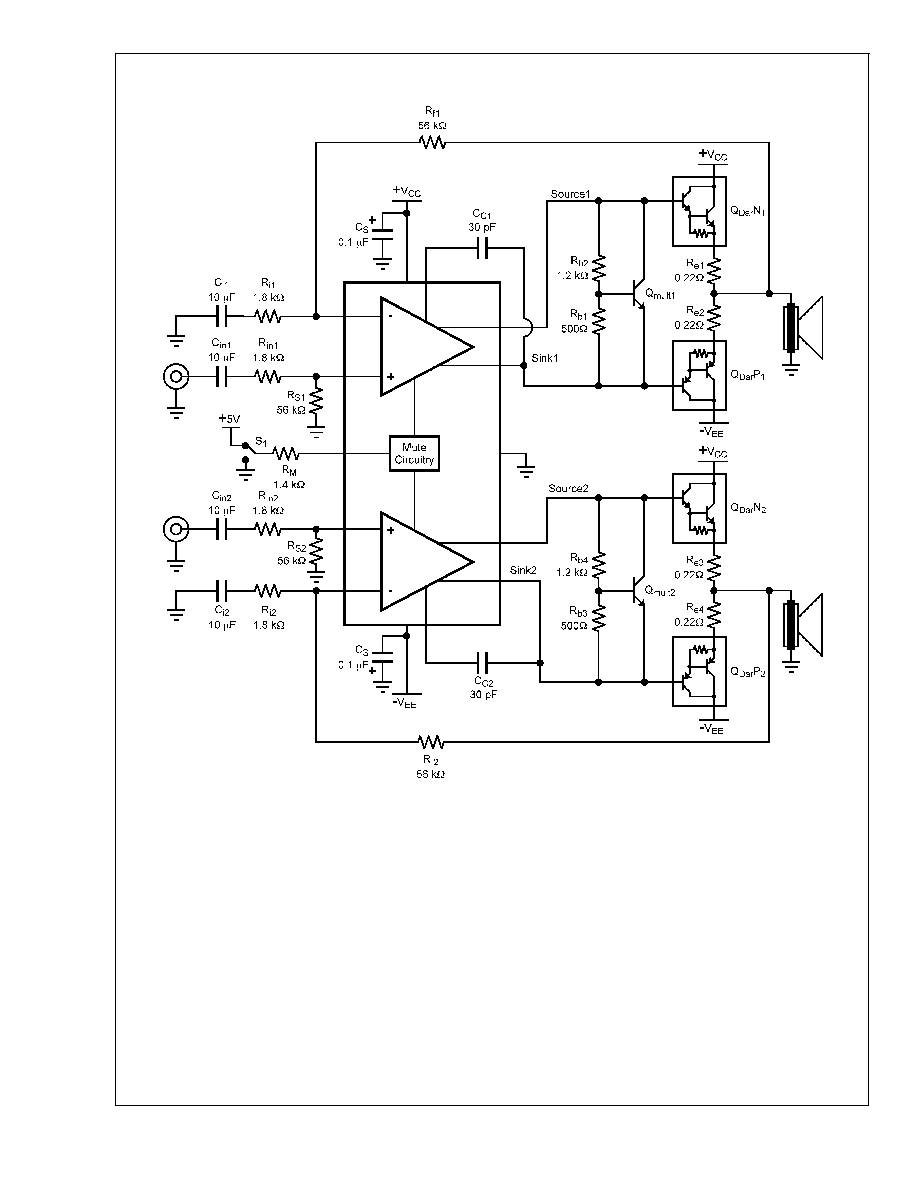
Typical Application and Connection Diagrams
(Continued)
20158319
FIGURE 1. Typical Audio Amplifier Application Circuit
LM4702
www.national.com
2

Connection Diagram
Plastic Package (For B and C) (Note 13)
20158301
Top View
Order Number LM4702T(B & C)
See NS Package Number TA15A
LM4702
www.national.com
3
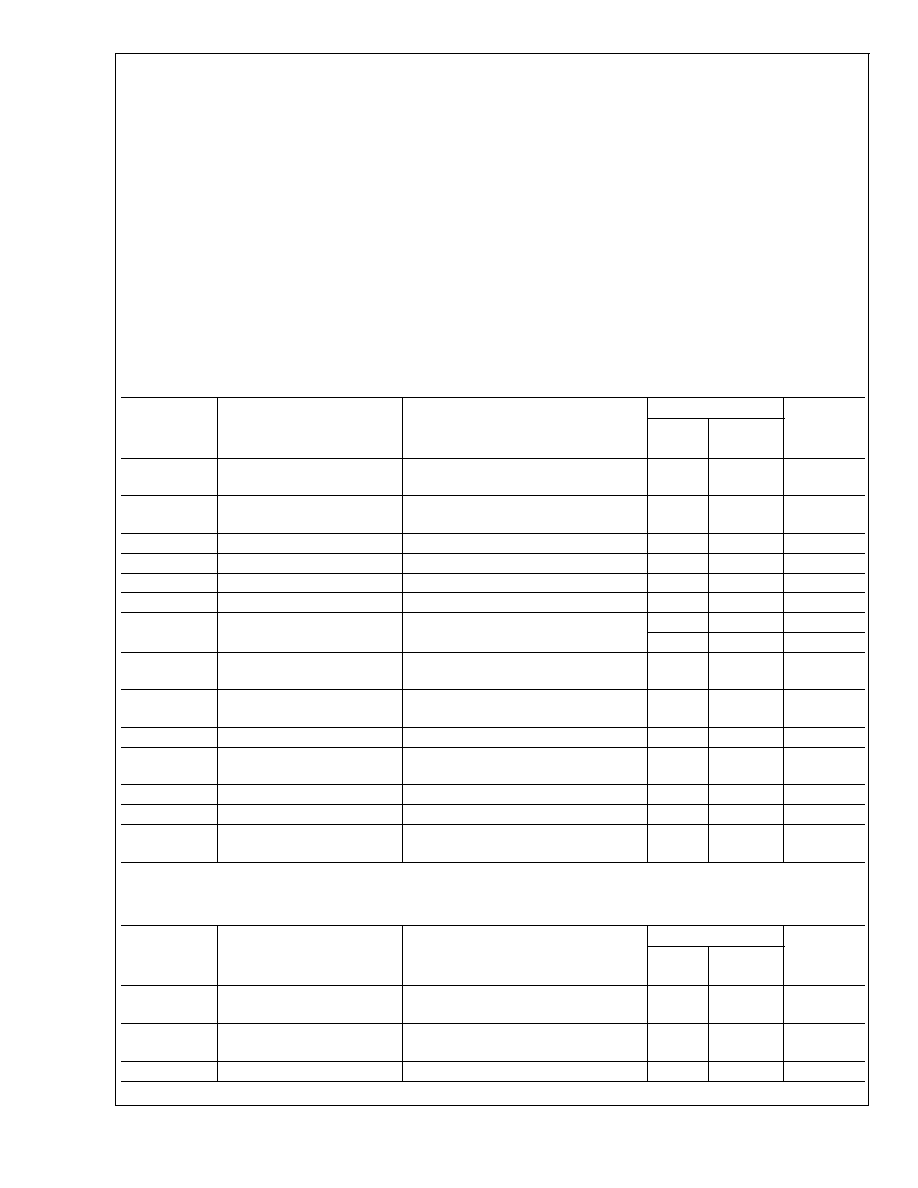
Absolute Maximum Ratings
(Notes 1,
2)
If Military/Aerospace specified devices are required,
please contact the National Semiconductor Sales Office/
Distributors for availability and specifications.
Supply Voltage |V
+
| + |V
-
|
200V
Differential Input Voltage
+/-6V
Common Mode Input Range
0.4 Vee to 0.4 Vcc
Power Dissipation (Note 3)
4W
ESD Susceptibility (Note 4)
1.5kV
ESD Susceptibility (Note 5)
200V
Junction Temperature (T
JMAX
) (Note 9)
150∞C
Soldering Information
T Package (10 seconds)
260∞C
Storage Temperature
-40∞C to +150∞C
Thermal Resistance
JA
30∞C/W
JC
1∞C/W
Operating Ratings
(Notes 1, 2)
Temperature Range
T
MIN
T
A
T
MAX
-20∞C
T
A
+75∞C
Supply Voltage |V
+
| + |V
-
|
LM4702A (in development)
+/-20V
V
TOTAL
+/-85V
LM4702B (in development)
+/-20V
V
TOTAL
+/-80V
LM4702C
+/-20V
V
TOTAL
+/-75V
Electrical Characteristics (LM4702C) Vcc = +75V, Vee = ≠75V
(Notes 1, 2)
The following specifications apply for I
MUTE
= 1.5mA, unless otherwise specified. Limits apply for T
A
= 25∞C.
Symbol
Parameter
Conditions
LM4702
Units
(Limits)
Typical
Limit
(Note 6)
(Notes 7, 8)
I
CC
Total Quiescent Power Supply
Current
V
CM
= 0V, V
O
= 0V, I
O
= 0A
25
30
mA (max)
THD+N
Total Harmonic Distortion +
Noise
No load, A
V
= 30dB
V
OUT
= 14V
RMS
@
1kHz
0.005
%
R
S
Input Bias Resistor
50
100
k
(max)
Av
Closed Loop Voltage Gain
26
dB (min)
Av open
Open Loop Gain
Vin = 1mVrms, f = 1KHz, C = 30pF
93
dB
Vom
Output Voltage Swing
THD = 0.05%, Freq = 20Hz to 20KHz
51
Vrms (min)
Vnoise
Output Noise
Rs = 10k
, LPF = 30kHz, Av = 30dB
A-weighted
150
300
µV (max)
90
µV
I
OUT
Output Current
Current from Source to Sink Pins
5.5
3
10
mA(min)
mA (max)
I
mute
Current into Mute Pin
To put part in "play" mode
1.5
1
2
mA(min)
mA (max)
X
TALK
Channel Separation (Note 11)
f = 1kHz
@
Av = 30dB
85
dB
SR
Slew Rate
V
IN
= 1.2V
P-P
, f = 10kHz square Wave,
Outputs shorted
15
V/µs
V
OS
Input Offset Voltage
V
CM
= 0V, I
O
= 0mA
10
35
mV (max)
I
B
Input Bias Current
V
CM
= 0V, I
O
= 0mA
500
nA
PSRR
Power Supply Rejection Ratio
Rs = 1k, f = 100Hz,
Vripple = 1Vrms, Input Referred
110
95
dB (min)
Electrical Characteristics (LM4702C) Vcc = +50V, Vee = ≠50V
(Notes 1, 2)
The following specifications apply for I
MUTE
= 1.5mA, unless otherwise specified. Limits apply for T
A
= 25∞C.
Symbol
Parameter
Conditions
LM4702
Units
(Limits)
Typical
Limit
(Note 6)
(Notes 7, 8)
I
CC
Total Quiescent Power Supply
Current
V
CM
= 0V, V
O
= 0V, I
O
= 0A
22
30
mA (max)
THD+N
Total Harmonic Distortion +
Noise
No load, A
V
= 30dB
V
OUT
= 10V
RMS
@
1kHz
0.005
%
R
S
Input Bias Resistor
50
100
k
(max)
LM4702
www.national.com
4
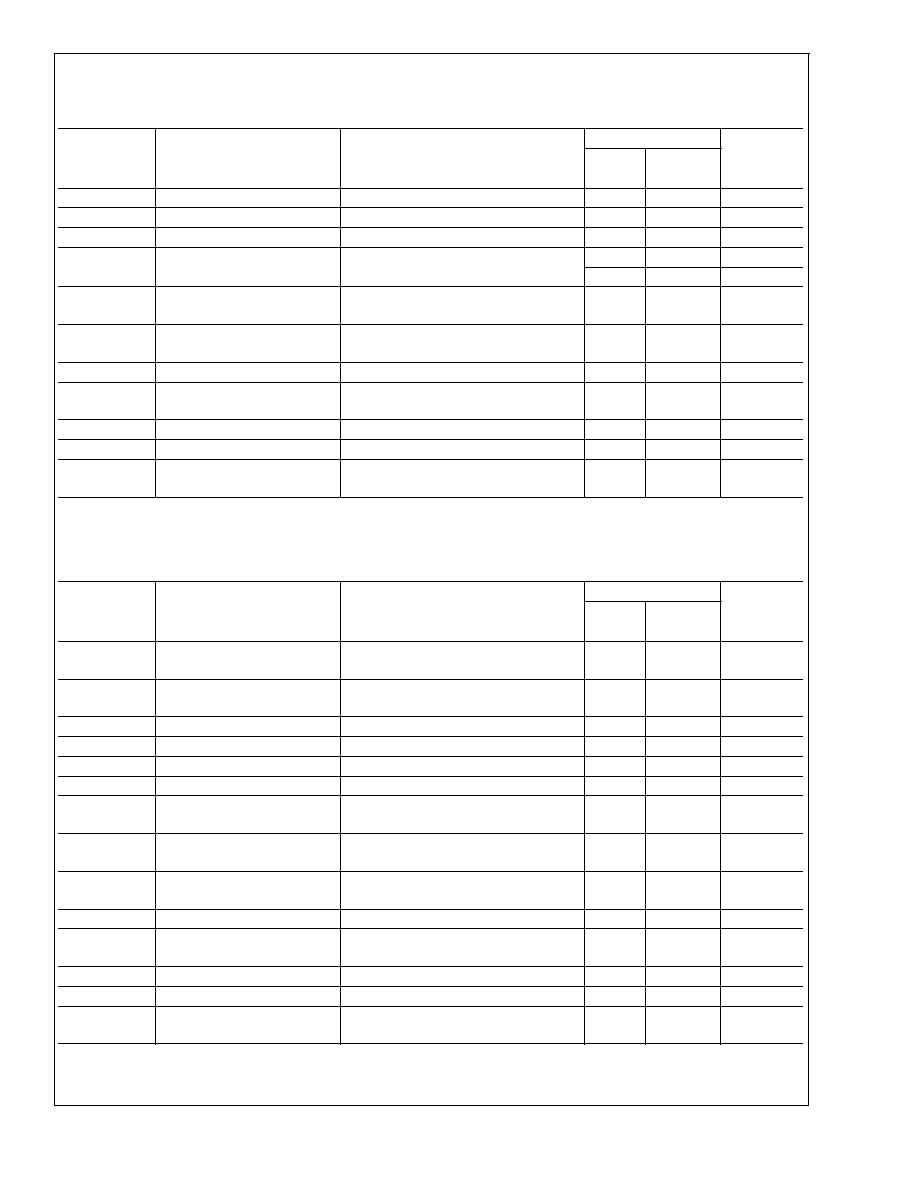
Electrical Characteristics (LM4702C) Vcc = +50V, Vee = ≠50V
(Notes 1,
2) (Continued)
The following specifications apply for I
MUTE
= 1.5mA, unless otherwise specified. Limits apply for T
A
= 25∞C.
Symbol
Parameter
Conditions
LM4702
Units
(Limits)
Typical
Limit
(Note 6)
(Notes 7, 8)
Av
Closed Loop Voltage Gain
26
dB (min)
Av open
Open Loop Gain
Vin = 1mVrms, f = 1KHz, C = 30pF
93
dB
Vom
Output Voltage Swing
THD = 0.05%, Freq = 20Hz to 20KHz
33
Vrms (min)
Vnoise
Output Noise
Rs = 10k
, LPF = 30kHz, Av = 30dB
A-weighted
150
300
µV (max)
90
µV
I
OUT
Output Current
Outputs Shorted
5.2
3
10
mA(min)
mA (max)
I
mute
Current into Mute Pin
To put part in "play" mode
1.5
1
2
mA(min)
mA (max)
X
TALK
Channel Separation (Note 11)
f = 1kHz at Av = 30dB
85
dB
SR
Slew Rate
V
IN
= 1.2V
P-P
, f = 10kHz square Wave,
Outputs shorted
15
V/µs
V
OS
Input Offset Voltage
V
CM
= 0V, I
O
= 0mA
10
35
mV (max)
I
B
Input Bias Current
V
CM
= 0V, I
O
= 0mA
500
nA
PSRR
Power Supply Rejection Ratio
Rs = 1k, f = 100Hz,
Vripple = 1Vrms, Input Referred
110
95
dB (min)
Electrical Characteristics (LM4702B) Vcc = +80V, Vee = ≠80V (Pre-release
information)
(Notes 1, 2)
The following specifications apply for I
MUTE
= 1.5mA, unless otherwise specified. Limits apply for T
A
= 25∞C.
Symbol
Parameter
Conditions
LM4702
Units
(Limits)
Typical
Limit
(Note 6)
(Notes 7, 8)
I
CC
Total Quiescent Power Supply
Current
V
CM
= 0V, V
O
= 0V, I
O
= 0A
27
TBD
mA (max)
THD+N
Total Harmonic Distortion +
Noise
No load, A
V
= 30dB
V
OUT
= 20V
RMS
@
1kHz
0.003
TBD
% (max)
R
S
Input Bias Resistor
50
TBD
k
(max)
Av
Closed Loop Voltage Gain
TBD
dB (min)
Av open
Open Loop Gain
Vin = 1mVrms, f = 1KHz, C = 30pF
93
dB
Vom
Output Voltage Swing
THD = 0.05%, Freq = 20Hz to 20KHz
54
TBD
Vrms (min)
Vnoise
Output Noise
Rs = 10k
, LPF = 30kHz, Av = 30dB
A-weighted
150
90
TBD
TBD
µV (max)
I
OUT
Output Current
Outputs Shorted
5.5
TBD
TBD
mA(min)
mA (max)
I
mute
Current into Mute Pin
To put part in "play" mode
1.5
TBD
TBD
mA(min)
mA (max)
X
TALK
Channel Separation (Note 11)
f = 1kHz at Av = 30dB
85
TBD
dB (min)
SR
Slew Rate
V
IN
= 1.2V
P-P
, f = 10kHz square Wave,
Outputs shorted
17
TBD
V/µs (min)
V
OS
Input Offset Voltage
V
CM
= 0V, I
O
= 0mA
7
TBD
mV (max)
I
B
Input Bias Current
V
CM
= 0V, I
O
= 0mA
350
TBD
nA (max)
PSRR
Power Supply Rejection Ratio
Rs = 1k, f = 100Hz,
Vripple = 1Vrms, Input Referred
110
TBD
dB (min)
LM4702
www.national.com
5
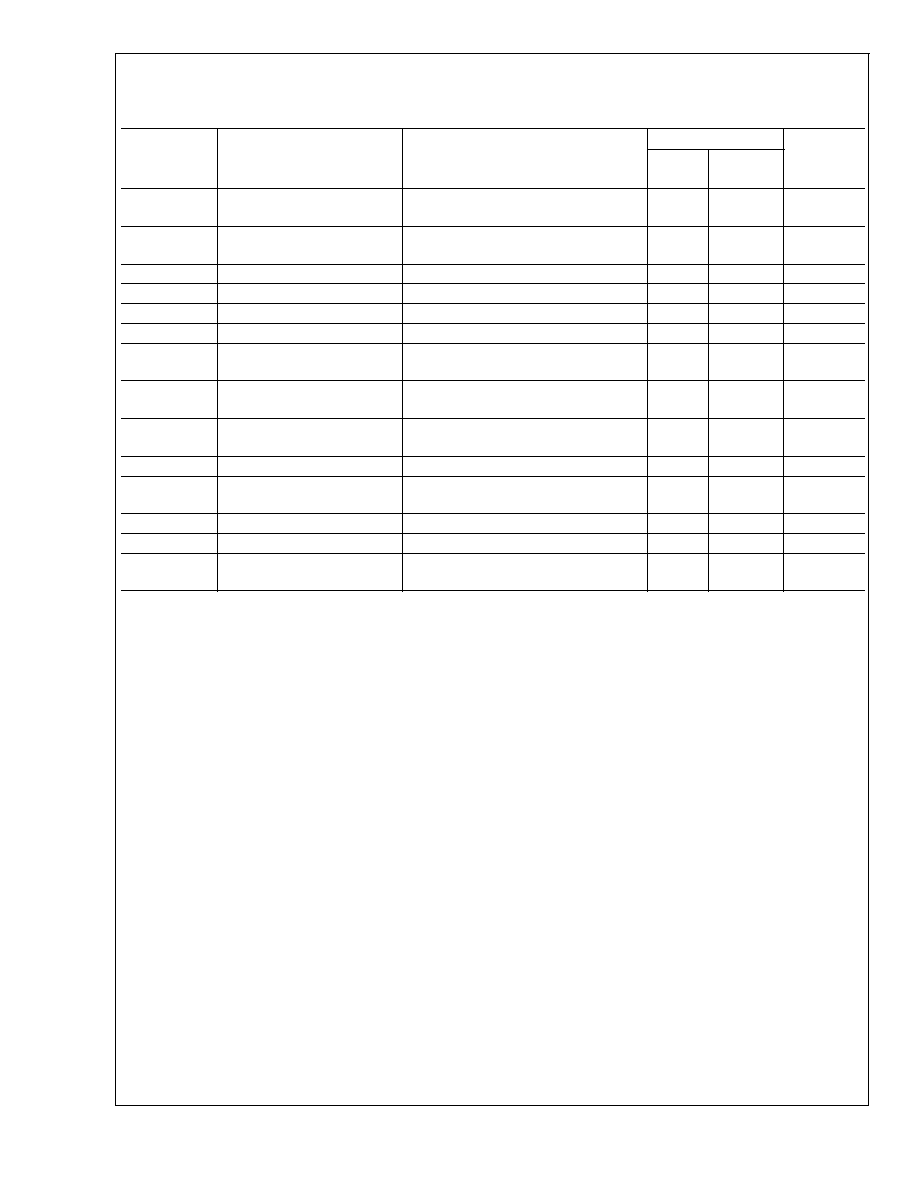
Electrical Characteristics (LM4702A) Vcc = +85V, Vee = ≠85V (Pre-release
information)
(Notes 1, 2)
The following specifications apply for I
MUTE
= 1.5mA, unless otherwise specified. Limits apply for T
A
= 25∞C.
Symbol
Parameter
Conditions
LM4702
Units
(Limits)
Typical
Limit
(Note 6)
(Notes 7, 8)
I
CC
Total Quiescent Power Supply
Current
V
CM
= 0V, V
O
= 0V, I
O
= 0A
27
TBD
mA (max)
THD+N
Total Harmonic Distortion +
Noise
No load, A
V
= 30dB
V
OUT
= 20V
RMS
@
1kHz
0.001
TBD
% (max)
R
S
Input Bias Resistor
50
TBD
k
(max)
Av
Closed Loop Voltage Gain
TBD
dB (min)
Av open
Open Loop Gain
Vin = 1mVrms, f = 1KHz, C = 30pF
93
dB
Vom
Output Voltage Swing
THD = 0.05%, Freq = 20Hz to 20KHz
57
TBD
Vrms (min)
Vnoise
Output Noise
Rs = 10k
, LPF = 30kHz, Av = 30dB
A-weighted
100
80
TBD
TBD
µV (max)
I
OUT
Output Current
Outputs Shorted
5.5
TBD
TBD
mA(min)
mA (max)
I
mute
Current into Mute Pin
To put part in "play" mode
1.5
TBD
TBD
mA(min)
mA (max)
X
TALK
Channel Separation (Note 11)
f = 1kHz at Av = 30dB
90
TBD
dB (min)
SR
Slew Rate
V
IN
= 1.2V
P-P
, f = 10kHz square Wave,
Outputs shorted
TBD
TBD
V/µs (min)
V
OS
Input Offset Voltage
V
CM
= 0V, I
O
= 0mA
5
TBD
mV (max)
I
B
Input Bias Current
V
CM
= 0V, I
O
= 0mA
150
TBD
nA (max)
PSRR
Power Supply Rejection Ratio
Rs = 1k, f = 100Hz,
Vripple = 1Vrms, Input Referred
110
TBD
dB (min)
Note 1: All voltages are measured with respect to the ground pins, unless otherwise specified.
Note 2: Absolute Maximum Ratings indicate limits beyond which damage to the device may occur. Operating Ratings indicate conditions for which the device is
functional, but do not guarantee specific performance limits. Electrical Characteristics state DC and AC electrical specifications under particular test condition which
guarantee specific performance limits. This assumes that the device is within the Operating Ratings. Specifications are not guaranteed for parameters where no limit
is given. However, the typical value is a good indication of device's performance.
Note 3: The maximum power dissipation must be de-rated at elevated temperatures and is dictated by T
JMAX
,
JC
, and the ambient temperature T
A
. The maximum
allowable power dissipation is P
DMAX
= (T
JMAX
-T
A
)/
JC
or the number given in the Absolute Maximum Ratings, whichever is lower. For the LM4702, T
JMAX
= 150∞C
and the typical
JC
is 1∞C/W. Refer to the Thermal Considerations section for more information.
Note 4: Human body model, 100pF discharged through a 1.5k
resistor.
Note 5: Machine Model: a 220pF - 240pF discharged through all pins.
Note 6: Typical specifications are measured at 25∞C and represent the parametric norm.
Note 7: Tested limits are guaranteed to National's AOQL (Average Outgoing Quality Level).
Note 8: Datasheet min/max specification limits are guaranteed by design, test, or statistical analysis.
Note 9: The maximum operating junction temperature is 150∞C.
Note 10: PCB layout will affect cross talk. It is recommended that input and output traces be separated by as much distance as possible. Return ground traces from
outputs should be independent back to a single ground point and use as wide of traces as possible.
Note 11: The TA15A is a non-isolated package. The package's metal back and any heat sink to which it is mounted are connected to the Vee potential when using
only thermal compound. If a mica washer is used in addition to thermal compound,
CS
(case to sink) is increased, but the heat sink will be electrically isolated from
Vee.
LM4702
www.national.com
6
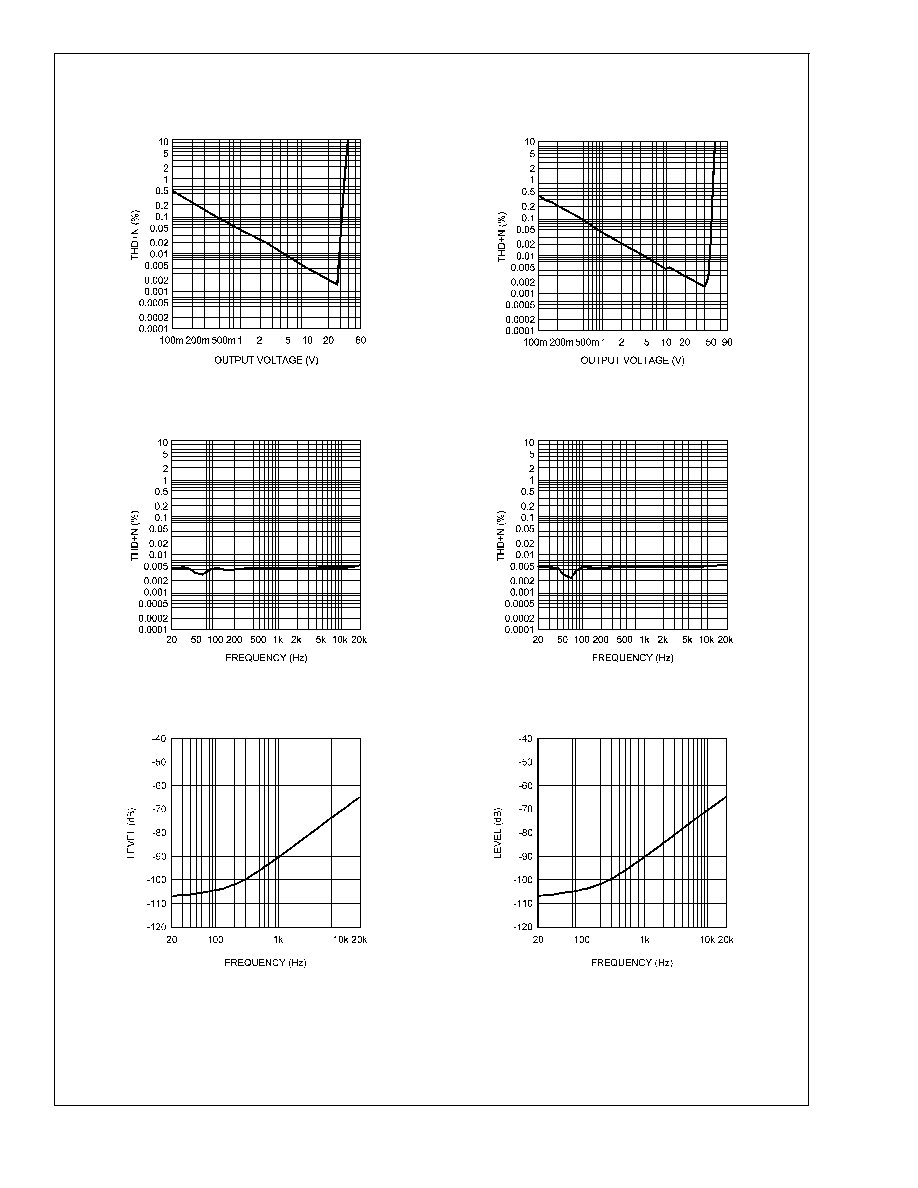
Typical Performance Characteristics for LM4702C
THD+N vs Output Voltage
V
DD
=
±
50V, f = 1kHz, outputs shorted
THD+N vs Output Voltage
V
DD
=
±
75V, f = 1kHz, outputs shorted
20158308
20158338
THD+N vs Frequency
V
DD
=
±
50V, V
OUT
= 10Vrms, outputs shorted
THD+N vs Frequency
V
DD
=
±
75V, V
OUT
= 14Vrms, outputs shorted
20158310
20158339
Crosstalk vs Frequency
V
DD
=
±
50V
Crosstalk vs Frequency
V
DD
=
±
75V
20158335
20158336
LM4702
www.national.com
7
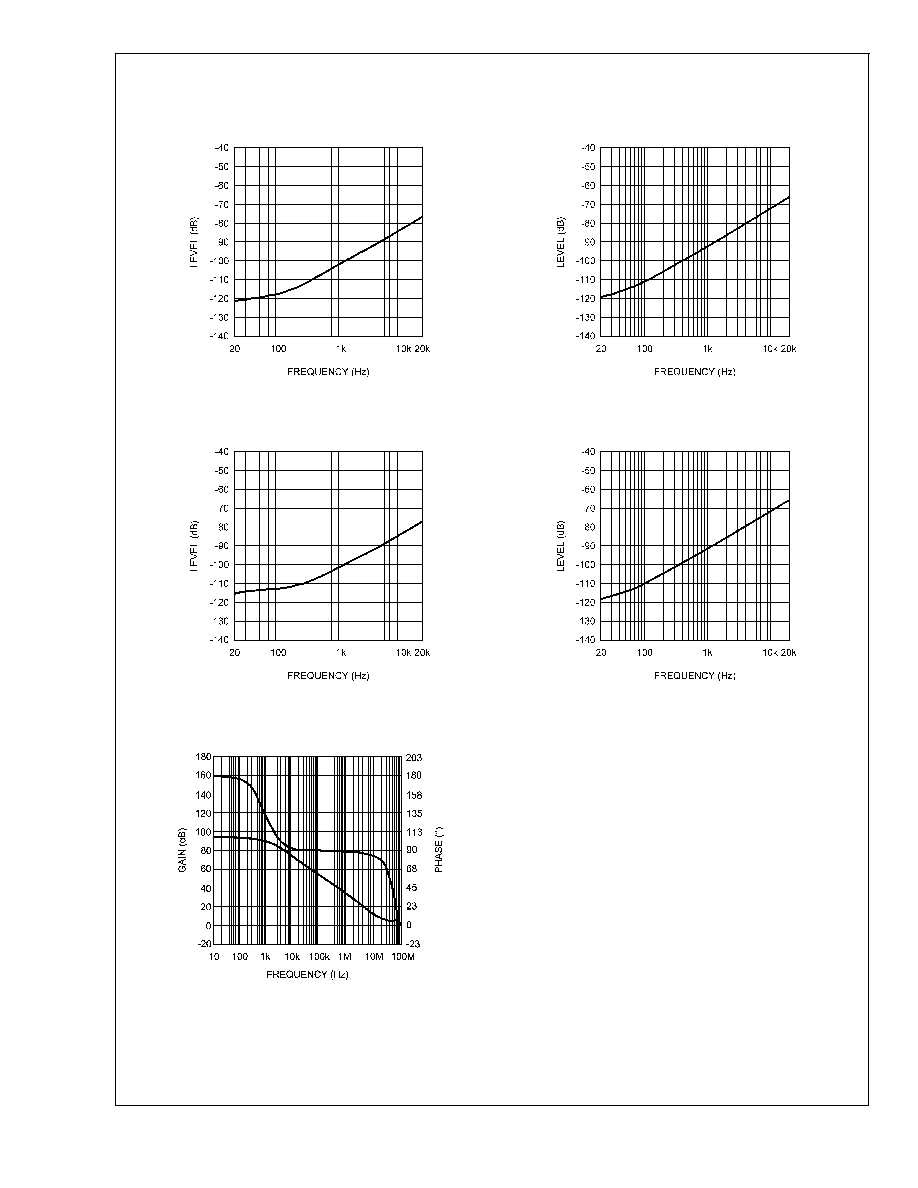
Typical Performance Characteristics for LM4702C
(Continued)
+PSRR vs Frequency
V
DD
=
±
50V, R
S
= 1k
, Ripple on V
CC
-PSRR vs Frequency
V
DD
=
±
50V, R
S
= 1k
, Ripple on V
ee
20158331
20158333
+PSRR vs Frequency
V
DD
=
±
75V, R
S
= 1k
, Ripple on V
CC
-PSRR vs Frequency
V
DD
=
±
75V, R
S
= 1k
, Ripple on V
ee
20158332
20158334
Open Loop and Phase
Upper-Phase, Lower-Gain
20158337
LM4702
www.national.com
8
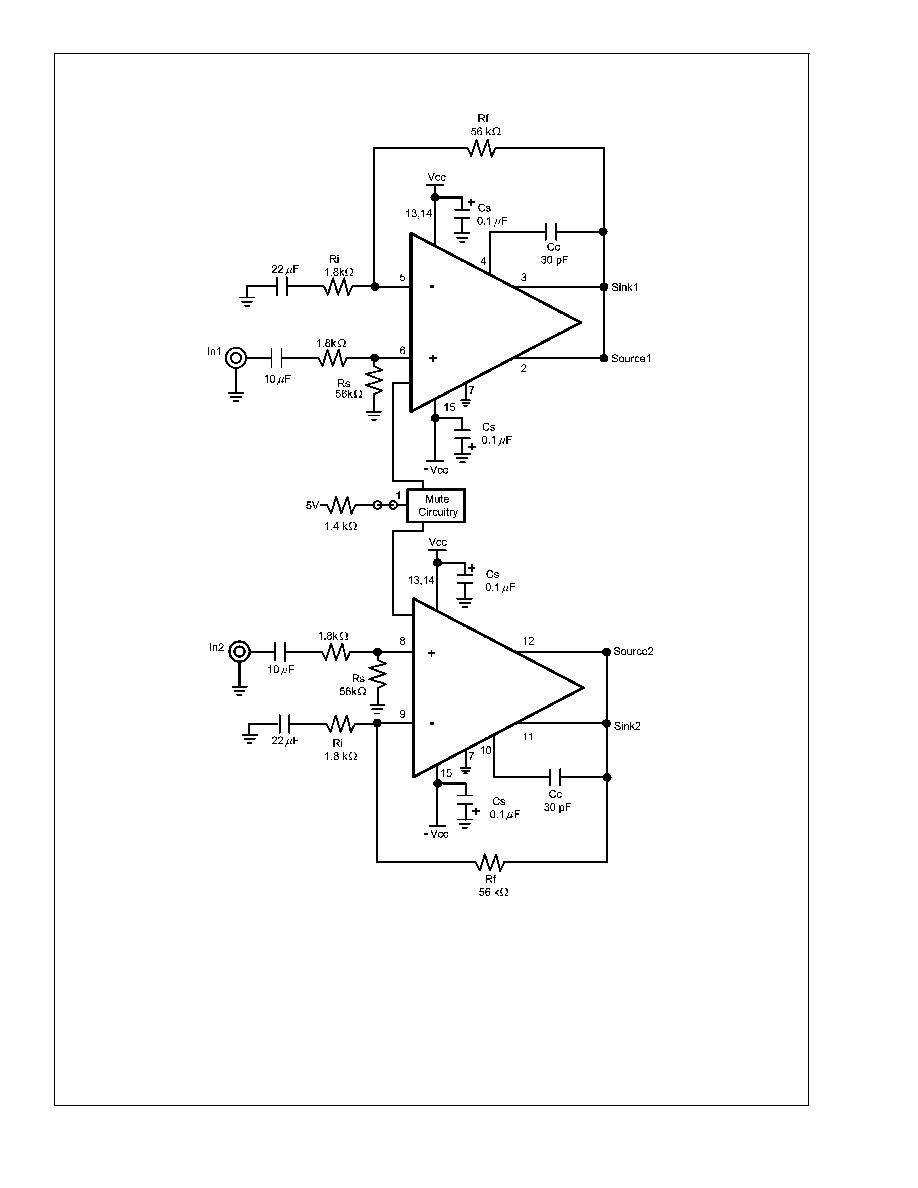
Test Circuit
20158303
FIGURE 1.
LM4702
www.national.com
9
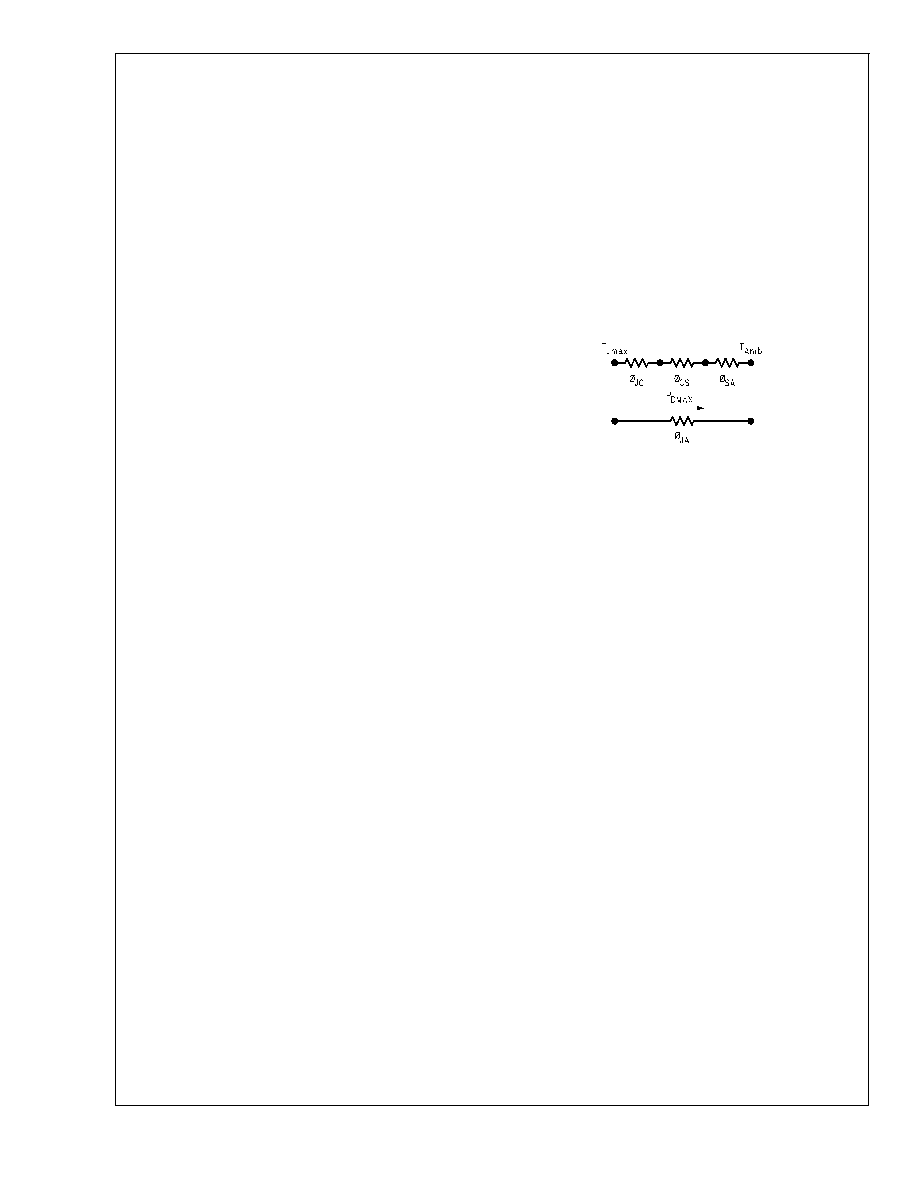
Application Information
MUTE FUNCTION
The mute function of the LM4702 is controlled by the amount
of current that flows into the mute pin. If there is less than
1mA of current flowing into the mute pin, the part will be in
mute. This can be achieved by shorting the mute pin to
ground or by floating the mute pin. If there is between 1mA
and 2mA of current flowing into the mute pin, the part will be
in "play" mode. This can be done by connecting a power
supply (Vmute) to the mute pin through a resistor (Rm). The
current into the mute pin can be determined by the equation
Imute = (Vmute ≠ 2.9) / Rm. For example, if a 5V power
supply is connected through a 1.4k resistor to the mute pin,
then the mute current will be 1.5mA, at the center of the
specified range. It is also possible to use Vcc as the power
supply for the mute pin, though Rm will have to be recalcu-
lated accordingly. It is not recommended to flow more than
2mA of current into the mute pin because damage to the
LM4702 may occur.
It is highly recommended to switch between mute and "play"
modes rapidly. This is accomplished most easily through
using a toggle switch that alternatively connects the mute pin
through a resistor to either ground or the mute pin power
supply. Slowly increasing the mute current may result in
undesired voltages on the outputs of the LM4702, which can
damage an attached speaker.
THERMAL PROTECTION
The LM4702 has a sophisticated thermal protection scheme
to prevent long-term thermal stress of the device. When the
temperature on the die exceeds 150∞C, the LM4702 shuts
down. It starts operating again when the die temperature
drops to about 145∞C, but if the temperature again begins to
rise, shutdown will occur again above 150∞C. Therefore, the
device is allowed to heat up to a relatively high temperature
if the fault condition is temporary, but a sustained fault will
cause the device to cycle in a Schmitt Trigger fashion be-
tween the thermal shutdown temperature limits of 150∞C and
145∞C. This greatly reduces the stress imposed on the IC by
thermal cycling, which in turn improves its reliability under
sustained fault conditions.
Since the die temperature is directly dependent upon the
heat sink used, the heat sink should be chosen so that
thermal shutdown is not activated during normal operation.
Using the best heat sink possible within the cost and space
constraints of the system will improve the long-term reliability
of any power semiconductor device, as discussed in the
Determining the Correct Heat Sink section.
POWER DISSIPATION AND HEAT SINKING
When in "play" mode, the LM4702 draws a constant amount
of current, regardless of the input signal amplitude. Conse-
quently, the power dissipation is constant for a given supply
voltage and can be computed with the equation P
DMAX
= Icc
* (Vcc ≠ Vee). For a quick calculation of P
DMAX
, approximate
the current to be 25mA and multiply it by the total supply
voltage (the current varies slightly from this value over the
operating range).
DETERMINING THE CORRECT HEAT SINK
The choice of a heat sink for a high-power audio amplifier is
made entirely to keep the die temperature at a level such
that the thermal protection circuitry is not activated under
normal circumstances.
The thermal resistance from the die to the outside air,
JA
(junction to ambient), is a combination of three thermal re-
sistances,
JC
(junction to case),
CS
(case to sink), and
SA
(sink to ambient). The thermal resistance,
JC
(junction to
case), of the LM4702T is 0.8∞C/W. Using Thermalloy Ther-
macote thermal compound, the thermal resistance,
CS
(case to sink), is about 0.2∞C/W. Since convection heat flow
(power dissipation) is analogous to current flow, thermal
resistance is analogous to electrical resistance, and tem-
perature drops are analogous to voltage drops, the power
dissipation out of the LM4702 is equal to the following:
P
DMAX
= (T
JMAX
-T
AMB
) /
JA
(1)
where T
JMAX
= 150∞C, T
AMB
is the system ambient tempera-
ture and
JA
=
JC
+
CS
+
SA
.
20158355
Once the maximum package power dissipation has been
calculated using equation 2, the maximum thermal resis-
tance,
SA
, (heat sink to ambient) in ∞C/W for a heat sink can
be calculated. This calculation is made using equation 4
which is derived by solving for
SA
in equation 3.
SA
= [(T
JMAX
-T
AMB
)-P
DMAX
(
JC
+
CS
)] / P
DMAX
(2)
Again it must be noted that the value of
SA
is dependent
upon the system designer's amplifier requirements. If the
ambient temperature that the audio amplifier is to be working
under is higher than 25∞C, then the thermal resistance for the
heat sink, given all other things are equal, will need to be
smaller.
PROPER SELECTION OF EXTERNAL COMPONENTS
Proper selection of external components is required to meet
the design targets of an application. The choice of external
component values that will affect gain and low frequency
response are discussed below.
The gain of each amplifier is set by resistors R
f
and R
i
for the
non-inverting configuration shown in Figure 1. The gain is
found by Equation (3) below:
A
V
= 1 + R
f
/ R
i
(V/V)
(3)
For best noise performance, lower values of resistors are
used. A value of 1k
is commonly used for R
i
and then
setting the value of R
f
for the desired gain. For the LM4702
the gain should be set no lower than 26dB. Gain settings
below 26dB may experience instability.
The combination of R
i
with C
i
(see Figure 1) creates a high
pass filter. The low frequency response is determined by
these two components. The -3dB point can be found from
Equation (4) shown below:
f
i
= 1 / (2
R
i
C
i
) (Hz)
(4)
If an input coupling capacitor is used to block DC from the
inputs as shown in Figure 5, there will be another high pass
filter created with the combination of C
IN
and R
IN
. When
using a input coupling capacitor R
IN
is needed to set the DC
LM4702
www.national.com
10

Application Information
(Continued)
bias point on the amplifier's input terminal. The resulting
-3dB frequency response due to the combination of C
IN
and
R
IN
can be found from Equation (5) shown below:
f
IN
= 1 / (2
R
IN
C
IN
) (Hz)
(5)
With large values of R
IN
oscillations may be observed on the
outputs when the inputs are left floating. Decreasing the
value of R
IN
or not letting the inputs float will remove the
oscillations. If the value of R
IN
is decreased then the value of
C
IN
will need to increase in order to maintain the same -3dB
frequency response.
AVOIDING THERMAL RUNAWAY WHEN USING
BIPOLAR OUTPUT STAGES
When using a bipolar output stage with the LM4702 (as in
Figure 1), the designer must beware of thermal runaway.
Thermal runaway is a result of the temperature dependence
of Vbe (an inherent property of the transistor). As tempera-
ture increases, Vbe decreases. In practice, current flowing
through a bipolar transistor heats up the transistor, which
lowers the Vbe. This in turn increases the current again, and
the cycle repeats. If the system is not designed properly, this
positive feedback mechanism can destroy the bipolar tran-
sistors used in the output stage.
One of the recommended methods of preventing thermal
runaway is to use a heat sink on the bipolar output transis-
tors. This will keep the temperature of the transistors lower.
A second recommended method is to use emitter degenera-
tion resistors (see Re1, Re2, Re3, Re4 in Figure 1). As
current increases, the voltage across the emitter degenera-
tion resistor also increases, which decreases the voltage
across the base and emitter. This mechanism helps to limit
the current and counteracts thermal runaway.
A third recommended method is to use a "Vbe multiplier" to
bias the bipolar output stage (see Figure 1). The Vbe multi-
plier consists of a bipolar transistor (Qmult, see Figure 1)
and two resistors, one from the base to the collector (Rb2,
Rb4, see Figure 1) and one from the base to the emitter
(Rb1, Rb3, see Figure 1). The voltage from the collector to
the emitter (also the bias voltage of the output stage) is
Vbias = Vbe(1+Rb2/Rb1), which is why this circuit is called
the Vbe multiplier. When Vbe multiplier transistor (Qmult,
see Figure 1) is mounted to the same heat sink as the bipolar
output transistors, its temperature will track that of the output
transistors. Its Vbe is dependent upon temperature as well,
and so it will draw more current as the output transistors heat
it up. This will limit the base current into the output transis-
tors, which counteracts thermal runaway.
LM4702
www.national.com
11
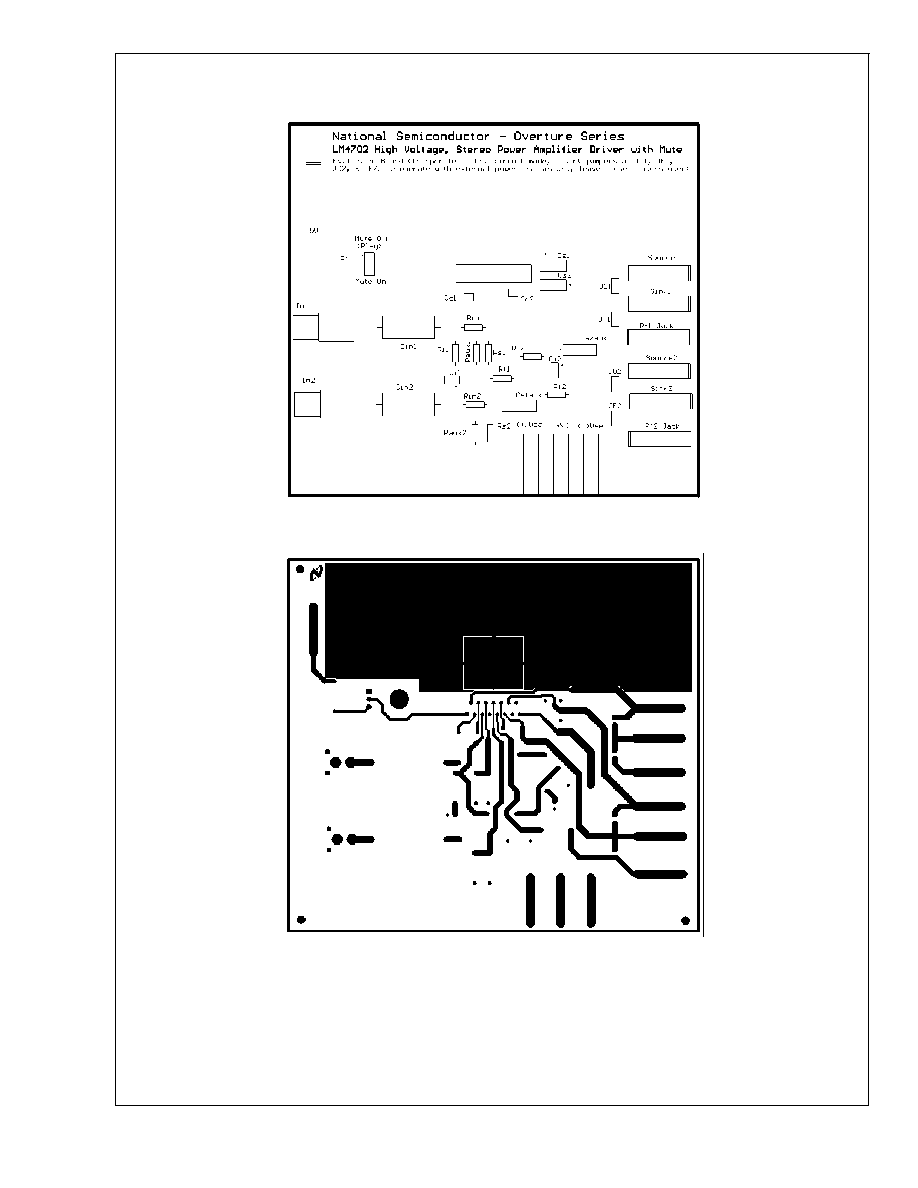
LM4702 Demo Board Artwork
Top Overlay
20158330
Top Layer
20158329
LM4702
www.national.com
12

LM4702 Demo Board Artwork
(Continued)
Bottom Layer
20158328
LM4702
www.national.com
13

Revision History
Rev
Date
Description
1.0
8/18/05
Input corrected data under the Typical
and Limit columns on all the 4 EC tables
(per Kevin H.).
1.1
8/22/05
Changed limits back on LM4702A/B/C to
±
85V/80V/75V respectively (under Key
Spec...)
1.2
8/31/05
First WEB released of the datasheet.
1.3
9/2/05
Due to miscommunication with the ASSY
plant (EM), the datasheet needs to be
taken off the WEB for now (per Robin
Simpson).
1.4
9/09/05
Taken out Limits on Vom (under the
+75V and +50V.. LM4702C EC tables),
then released D/S to the WEB (per Robin
Simpson).
1.5
9/14/05
Changed TM to R ( Overture R) in the
doc title (per Kevin C), Naomi Mitchell
called Kevin about it.
1.6
9/15/05
Re-released D/S to the WEB with
Overture "R".
LM4702
www.national.com
14
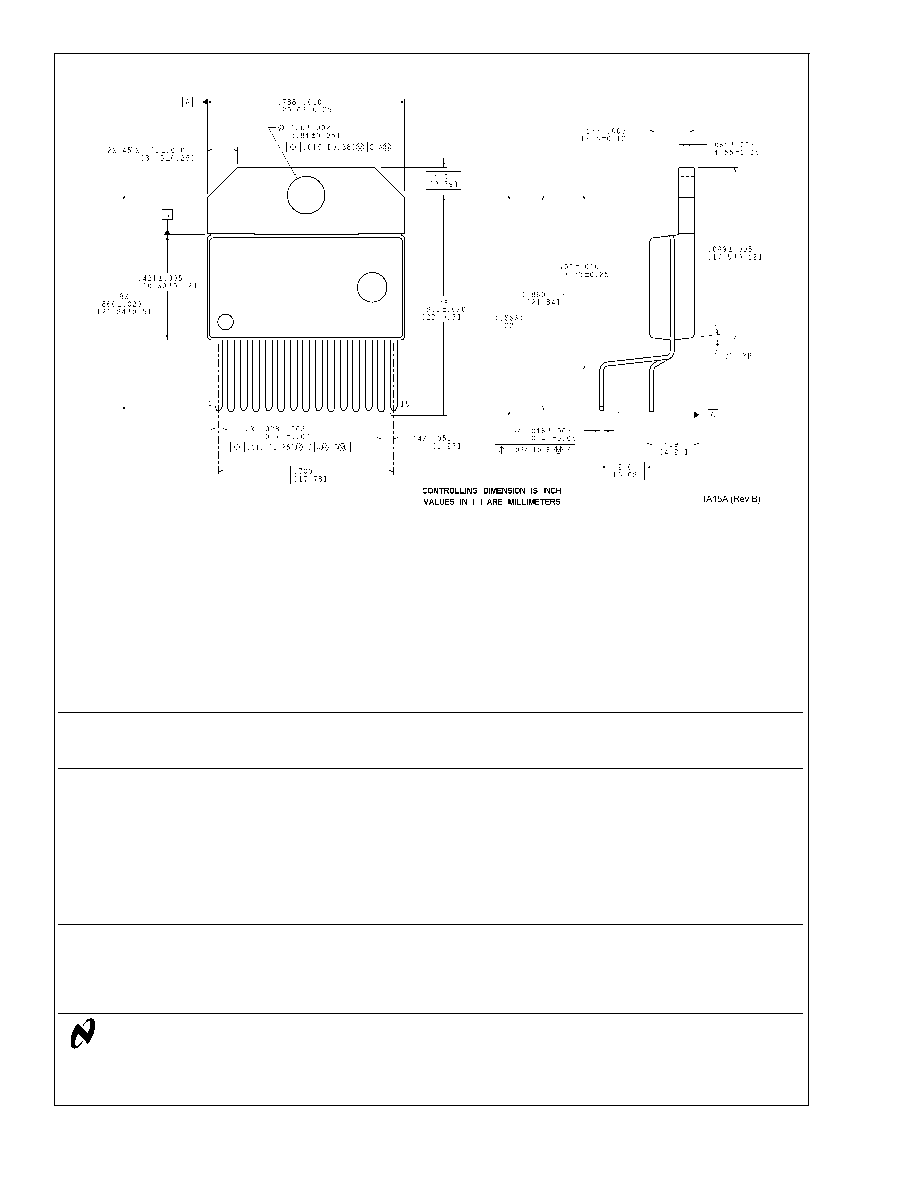
Physical Dimensions
inches (millimeters) unless otherwise noted
Non-Isolated TO-220 15-Lead Package
Order Number LM4702T(B&C)
NS Package Number TA15A
National does not assume any responsibility for use of any circuitry described, no circuit patent licenses are implied and National reserves
the right at any time without notice to change said circuitry and specifications.
For the most current product information visit us at www.national.com.
LIFE SUPPORT POLICY
NATIONAL'S PRODUCTS ARE NOT AUTHORIZED FOR USE AS CRITICAL COMPONENTS IN LIFE SUPPORT DEVICES OR SYSTEMS
WITHOUT THE EXPRESS WRITTEN APPROVAL OF THE PRESIDENT AND GENERAL COUNSEL OF NATIONAL SEMICONDUCTOR
CORPORATION. As used herein:
1. Life support devices or systems are devices or systems
which, (a) are intended for surgical implant into the body, or
(b) support or sustain life, and whose failure to perform when
properly used in accordance with instructions for use
provided in the labeling, can be reasonably expected to result
in a significant injury to the user.
2. A critical component is any component of a life support
device or system whose failure to perform can be reasonably
expected to cause the failure of the life support device or
system, or to affect its safety or effectiveness.
BANNED SUBSTANCE COMPLIANCE
National Semiconductor manufactures products and uses packing materials that meet the provisions of the Customer Products
Stewardship Specification (CSP-9-111C2) and the Banned Substances and Materials of Interest Specification (CSP-9-111S2) and contain
no ``Banned Substances'' as defined in CSP-9-111S2.
Leadfree products are RoHS compliant.
National Semiconductor
Americas Customer
Support Center
Email: new.feedback@nsc.com
Tel: 1-800-272-9959
National Semiconductor
Europe Customer Support Center
Fax: +49 (0) 180-530 85 86
Email: europe.support@nsc.com
Deutsch Tel: +49 (0) 69 9508 6208
English
Tel: +44 (0) 870 24 0 2171
FranÁais Tel: +33 (0) 1 41 91 8790
National Semiconductor
Asia Pacific Customer
Support Center
Email: ap.support@nsc.com
National Semiconductor
Japan Customer Support Center
Fax: 81-3-5639-7507
Email: jpn.feedback@nsc.com
Tel: 81-3-5639-7560
www.national.com
LM4702
Overture
Æ
Stereo
High
Fidelity
200
V
olt*
Driver
with
Mute














